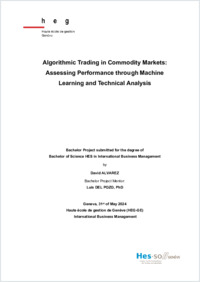Algorithmic trading in commodity markets : assessing performance through machine learning and technical analysis
SONAR|HES-SO
- Alvarez, David
- Del Pozo, Luis (Degree supervisor)
- Genève : Haute école de gestion de Genève
101 p.
Bachelor of Science HES-SO in International Business Management: Haute école de gestion de Genève, 2024
English
This research evaluates the effectiveness of machine learning (ML) and technical analysis strategies in commodity trading. Six strategies were backtested across various commodity futures markets: three based on technical indicators (simple moving average crossover, dual momentum crossover, and momentum strategy in volume) and three using machine learning algorithms (Logistic Regression, Decision Tree, and Random Forest). The performance of these strategies was evaluated using win rate, profit factor and Sharpe ratio.
The analysis revealed that ML, particularly the Random Forest model, often outperformed technical analysis strategies and their counterparts in terms of riskadjusted returns and profitability. This success can be attributed to ML's ability to capture complex, non-linear relationships within market data. However, the effectiveness of trading strategies varied significantly across different commodity markets and market phases. While machine learning strategies demonstrated resilience in certain periods, particularly during phases of steady volatility, they encountered notable challenges amidst periods of heightened volatility or significant market events, with the exception of Random Forest, which tended to maintain its performance.
Firms interested in using machine learning models for commodity trading could benefit from several key recommendations. First, they should prioritize a robust data strategy by ensuring clean, relevant, and diverse market-specific input variables combining a mix of technical indicators, sentiment analysis, fundamental and market-depth data to capture different market patterns. These choices need to be driven by feature selection methods and analysis. Feature engineering is also vital, involving data transformation, creating new indicators, and aggregating information across various timeframes. For model development, leveraging hybrid models can offer an edge, and ensuring adaptability by developing models that can adjust to different markets with regular recalibration. Incorporating integrated risk management principles within the models, such as position sizing based on volatility is also critical.
The analysis revealed that ML, particularly the Random Forest model, often outperformed technical analysis strategies and their counterparts in terms of riskadjusted returns and profitability. This success can be attributed to ML's ability to capture complex, non-linear relationships within market data. However, the effectiveness of trading strategies varied significantly across different commodity markets and market phases. While machine learning strategies demonstrated resilience in certain periods, particularly during phases of steady volatility, they encountered notable challenges amidst periods of heightened volatility or significant market events, with the exception of Random Forest, which tended to maintain its performance.
Firms interested in using machine learning models for commodity trading could benefit from several key recommendations. First, they should prioritize a robust data strategy by ensuring clean, relevant, and diverse market-specific input variables combining a mix of technical indicators, sentiment analysis, fundamental and market-depth data to capture different market patterns. These choices need to be driven by feature selection methods and analysis. Feature engineering is also vital, involving data transformation, creating new indicators, and aggregating information across various timeframes. For model development, leveraging hybrid models can offer an edge, and ensuring adaptability by developing models that can adjust to different markets with regular recalibration. Incorporating integrated risk management principles within the models, such as position sizing based on volatility is also critical.
- Language
-
- English
- Classification
- Economics
- Notes
-
- Haute école de gestion Genève
- International Business Management
- hesso:hegge
- Persistent URL
- https://folia.unifr.ch/global/documents/330831
Statistics
Document views: 77
File downloads:
- BT_ALVAREZ_David_2024.pdf: 282
